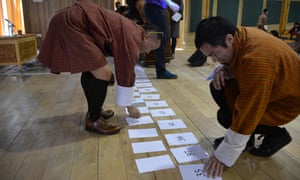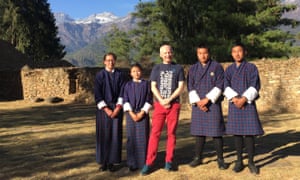Bhutan solves the ultimate school maths problem – and the answer is 108
Oxford mathematician Marcus du Sautoy visits the mountain kingdom, which is successfully taking on the challenge of inspiring children to love maths
Every country around the world is trying to crack one of the toughest mathematical conundrums on the books. Not the Riemann hypothesis or the Navier-Stokes equations but the challenge of how to get schoolchildren to fall in love with mathematics.
One country trying an innovative approach to the challenge is the tiny kingdom of Bhutan, tucked away at the top of the Himalayas. Famous for its decision to measure its wealth not just economically but also via the idea of gross national happiness, Bhutan is trying to find a way to get its children to be happier in mathematics lessons. Having long been inspired by the Indian curriculum, which favours rules and rote learning, the emphasis is shifting to giving students an understanding of why and how these rules work.
Last week, at the invitation of the Royal Tutorial Project in Bhutan, and with support from the British high commission in India, I braved altitude sickness and one of the most terrifying plane landings in the world, to give a series of workshops to help teachers transition to the new curriculum.
Faced with a lecture theatre full of teachers dressed in their traditional ghos (knee-length robes rather like kimonos, worn by men) and kiras (the ankle-length dress worn by women), I wondered if my experience as an academic at Oxford University would resonate at all.
To break the ice, I told stories about my favourite numbers: the primes. After all, 17 is as much an indivisible number in Bhutan as it is in the quads of Oxford.
“Can primes help me to understand the significance of the number 108 in Buddhism?” Kesang, a teacher from the Punakha valley asked me as we broke for a morning snack of momos, a Bhutanese dumpling. Never one to shirk a challenge, I said my first instinct would be to pull the number apart into its prime divisors to see how it is made: 108=2x2x3x3x3.
As it turns out, this does relate to one of the explanations of the significance of 108 in Buddhism. Kesang explained to me that Buddhists believe we have six senses: our five western senses together with the sixth sense of consciousness. These senses can be experienced in three ways: good, bad or indifferent. They can also be internal or external to the body. Finally they can be in the past, present or future. Which gives (2x3)x3x2x3=108 different categories of senses.
As we began to explore the number further, we found more mathematical connections. I’d driven over the high pass of Dochula on my way to Punakha valley and had stopped to take photos of the stupas (dome-shaped Buddhist shrines) that adorn the peak. “You know there are 108 stupas up there,” chipped in another teacher called Chime from Punakha central school. We began to think about how the stupas might be arranged. If one views 108 geometrically then it has nice properties because of its high divisibility. Take a 3x3 grid and in each square, place 12 stupas arranged in a 3x4 pattern and you get a very satisfying arrangement of 108 stupas.
This idea of mathematical connections is another important theme in the new curriculum. The textbooks are enriched with mathematical vignettes – intended to fire students’ imagination. For example, the curriculum exposes Bhutanese students to the idea of fractals (a mathematical set that exhibits a repeating pattern displayed at every scale) and topology (the mathematics that explains the geometry of networks such as the internet or maps such as the London underground). This is the poetry of mathematics that inspires a student to learn the grammar and vocabulary of the subject so that they can master and appreciate the the bigger ideas.
Jigme, a teacher from the Royal Academy, a school near Paro founded by the king of Bhutan, explained how he got students to appreciate the formula for the area of a circle by getting them to cut circles up into triangles. By rearranging the triangles into a rectangle, students could see why the area of the circle was πr2. By physicalising the mathematics the students could understand why the formula worked and not just learn it as a rule. “We’ve seen 80% dissatisfaction turn into 96% enjoyment in maths with this new approach,” he told me.
Rinchen, who is training to be a maths teacher at the Paro College of Education, explained how this idea of connections resonates deeply with one of the key characteristics of Bhutan’s Buddhist culture. “Buddhism teaches the highly interconnected nature of the universe. Nothing should be regarded in isolation. It is important to see how mathematics connects with things beyond the classroom,” he told me.
It is a philosophy that is desperately missing from most education systems where a student goes from the maths lesson, to the music lesson, to the history lesson, never realising how interconnected these subjects are.
Another important message of Buddhism is the concept of the middle way. Buddha teaches a path of moderation between the extremes of sensual pleasure and self-mortification. At lunch with the prime minister, Tshering Tobgay, while I was in Bhutan, he expressed concern that the curriculum might not deliver the basics his students need. “All well and good to understand why the maths works like it does but you still need to know your multiplication tables.” But the teachers I talked to recognised that the exciting new potential of this curriculum must be balanced with ensuring students learn the basics, even if that is by rote. As Sonam, a teacher from Drugyel central school, put it: “A musician must spend time learning scales as well as playing Zhungdra [the traditional folk music of Bhutan].”
It was exciting to see how Bhutan is seizing the initiative in making sure its students value and enjoy mathematics – that mathematics might help to increase the nation’s gross national happiness rather than depressing it.
As Karma, a mathematics teacher from Thimphu, Bhutan’s capital, puts it: “There is too much emphasis on just learning the rules of mathematics. [Students] may know how to apply the rules to a very high level but learning by rote doesn’t endear the subject to students.”
The importance Bhutan is attaching to the role education will play in shaping the country’s future is evident in the interest both the government and the royal family took in my visit to their country.
In a private audience with the king of Bhutan while I was there, he told me that he wanted his subjects to be fluent in three languages. “Dzongkha, the national language of Bhutan, so that they will always be connected to their unique culture and heritage. English because this allows them to connect and communicate with the rest of the world. And the language of mathematics because this is the language that will allow them to navigate the universe and to plan for an uncertain future.”
Marcus du Sautoy is the Simonyi professor for the public understanding of science and a professor of mathematics at the University of Oxford.








No comments:
Post a Comment